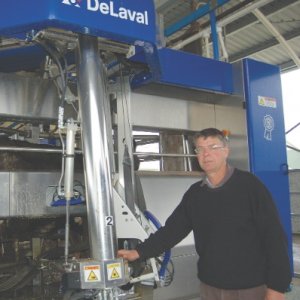John Fisher and his wife Margaret farm 80ha (eff), this season looking to milk 330–340 cows on the farm they’ve run for 30 years.
Fisher in March 2011 set up his DeLaval voluntary milking system (VMS), with four robotic milkers, “and was surprised how quickly [his] cows adjusted,” DeLaval says.
Said John Fisher, “It probably took us longer than the cows to recognise and solve problems. You spend half your time thinking like a cow. And you realise, actually, they’re not that dumb after all.”
Fisher had been a keen observer of DairyNZ’s Ruakura robotic milking research that kicked off in early 2001, De Laval says. For him, DairyNZ made a breakthrough by starting a three-way grazing system in the mid-2000s, “which means you are offering the cows fresh grass every eight hours.”
Fisher, while he was evaluating whether to make the move to robots, in 2006 visited an Australian VMS system. He says by 2010 the VMS “was at a price we were comfortable with, and [we] could see how the whole system would work on this farm.”
Along with the robotics, DeLaval selection gates were set up for before and after each cow is milked. Concentrate is available in the VMS, and feeding troughs feed the cows when they leave the robots.
Cows suffering lameness or mastitis can be pre-programmed on the computer system to be drafted off if required; these cows are then guided to a holding paddock.
Fisher says the cost of the system is about twice the per-cow cost of a good rotary setup. “But, you’re not having to put cups on cows yourself.”
Converting to the robotic system three quarters of the way through the milking season, instead of at calving, was a deliberate decision.
“We figured, starting at calving, that we’d rather be concerned with [all the issues of getting cows up and running], than with getting the cows used to the system. By beginning and teaching towards the end of the milking season, we were able to concentrate on the robotic milking setup itself.”
With one and a half season’s use behind them, Fisher says cows that were used to the system got straight back into it once they calved. For heifers calving for the first time, Fisher and his farm manager Gareth Purdie have been slightly more hands-on, guiding the new ones through and giving them time to get used to the operation.
A couple of weeks prior to their calving, the heifers were put through the VMS, given a teat spray and fed a small amount of meal, though the cups weren’t put on. A third of the heifers took up to three weeks to settle down and be comfortable with the system.
Fisher says that as well as the obvious difference of not having to get up at 4.30am to start milking, automatic milking gives him time to focus on individual cow attention and pasture management, thereby increasing productivity. “If you offer too much pasture, the cows won’t come back to the VMS,” he says.
His VMS has been set up to milk a cow on average 1.5 times a day, with their current throughput 1.7 times a day. If the figure slips below 1.5, “then you realise they’re probably getting too much pasture, and haven’t got that incentive to walk to the robot.”
He says that now the system has bedded in, the results in the vat and budgets should be more telling. Labour costs have reduced, though running costs and maintenance are slightly up.
















